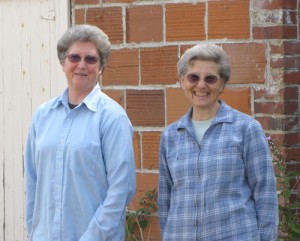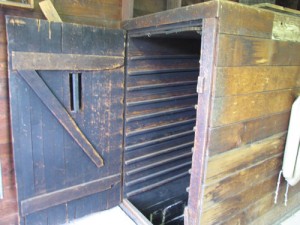Although Sister Theresa Henscheid and Sister Robin Lynn Evans are going to get a little more sleep than they normally would at this time of year, they are not exactly happy about it.
The women, who belong to the Benedictine Sisters of Mount Angel, run the historic wood fired fruit and nut dryer on the monastery grounds.
“Getting up at night gets a little tiring. We used to trade off hours, but now we trade nights and it works better. But in the end it is very rewarding,” Evans said.
The fruit dryer, which most years is packed with fruit, is empty and cold this year due to the poor harvests of fruit and nuts this summer.
“This is the barest year we have ever had,” Henscheid said. But the women are anticipating that next year the dryer will be up and running once more.
The fruit and nut dryer, which was built in 1924, is listed on the United States National Register of Historic Places. It is completely run on wood to dry the foods.
Henscheid, 75, and Evans, 57, are the caretakers for the monastery grounds and it is part of their job to run the dryer, although it is task they seem to love.
“Lots of sisters that ran the dryer before us did it differently, such as sleeping in the dryer building to keep the stove stoked with wood,” Henscheid said. “We now each take turns in staying up all night for a week to keep the wood fires going.”
The wood furnace is fed a mixture of cedar and pine, although oak keeps a longer burn in the rare dryer.
“Generally each year we have 80-110 lugs of prunes, each of the lugs weighing about 20 pounds. The prunes are picked fairly ripe and we dry then with the seed still in as we find that they dry better,” Henscheid said. “We do this all in one day to get them in the dryer. It is an all day process and then they dry for around a week, although some people pull them out while they are still hot to snack on them.”
The old wooden dryer that smells nicely of woodsmoke and fruit can take 49 large trays of prunes at a time.
“We wash, check over for bad fruit, remove stems before we put them on the trays. After a couple of days in the dryer, we check and rotate the trays to make sure they are evenly drying,” Evans said.
The prunes and other fruit are used for the monestary meals and snacks.
“It is rewarding to see the end product and people enjoying them,” Henscheid said. “Today the way things are processed and packaged at other places, people really enjoy the taste of our fruit, as it tastes like the old way style.”
They are looking forward to next summer and hopefully brings a bountiful crop.
